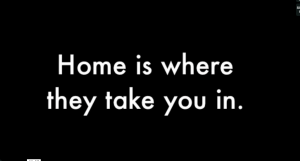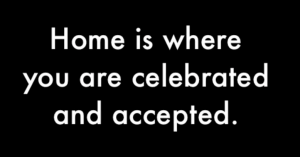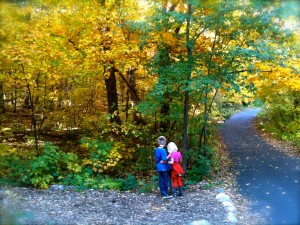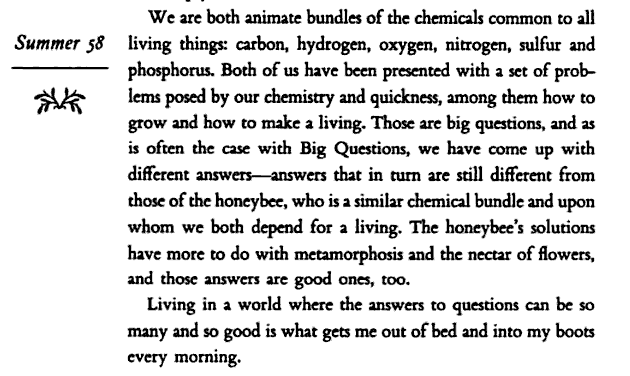I just watched a video by Jake Barton of Local Projects (via Explore) called Story(Us): The Power of Collaborative Storytelling.
In this short film, Jake Barton discusses the importance of not only sharing our stories with each other, but of collaborating with each other to create a unified, coherent, grand Story together. While I really appreciate the value he places on storytelling and the power it has in enabling us to connect and collaborate, I was bothered (surprise, surprise) by his idea that this collaborate storytelling ultimately should (and often does) lead to the recognition that, as one narrator states, “we are all the same.”
Do we need a grand narrative (a singular Story) to have meaningful connections? Must our ultimate conclusion be that our differences don’t really matter, that deep down, we are all the same? These are genuine questions, although I ask them provocatively and with my own responses in mind: “why?” and “No!”
I was troubled my the larger claims of this film from the beginning, when Barton describes the power of the moon landing. He says:
We are able to go up to that thing we see in the sky, the moon. And the fact that that object has been shared by every human in every civilization for decades and centuries and millenia, is unbelievable because then the moment when one human being steps on it, it actually unites an entire world around that idea: We did it.
Such a claim seems to erase all of the politics behind who the “we” was that actually did it (the U.S.) and for what purposes (at least partially, to beat Russia and claim U.S. superiority in space and everything else). I don’t know that much about the space race in the 60s, but I do know that it took place in the context of the Cold War, an extreme fear of Russia and communism and the vigilant practice of an Us versus Them mentality. Even if we accept, in a broader sense, that the fact that someone (anyone) was able to travel to the moon meant something to us-as-humans, what do we make of what happens not too long after Neil Armstrong took his historic step onto the moon, when he and Buzz Aldrin planted a U.S. Flag on the surface? What does the planting of the U.S. flag mean for a common, coherent narrative about Us?
My point in posing these questions is to trouble the idea that sharing and collaborating on stories brings us together by erasing our differences and reminding us that we are, ultimately, all the same. I like hearing stories that resonate with me and that enable me to see how my experiences can be similar to others. And some stories that I hear do prompt me to think, “wow, we aren’t all that different.” But, sharing and collaborating on stories does not require that we erase/ignore/suppress our differences or the political context in which those differences come to matter. The realization that differences matter does not mean that we can’t connect, share, collaborate or get along with others. It means that those connections shouldn’t demand that we create a singular narrative of commonality.
Later on in the film, Barton discusses how the diversity of stories and media outlets for sharing those stories presents us with a big challenge: “Whether or not that diversity for media does create understanding between people.” Barton’s response:
Today, we have the capacity to gather those stories together, to filter them, to make meaning out of them, to curate them and to make a larger narrative that binds us altogether.
Again, I wonder, do we need one larger narrative to bind us altogether? Who gets to filter/craft that narrative? Who doesn’t? What gets left out of the story/stories when we put too much emphasis on a coherent, singular story?
I like Barton’s definition of collaborative storytelling:
Collaborative storytelling can be a better way to understand the human experience. Because it’s necessarily as diverse and gritty and strange and unexpected as any of us could imagine.
What happens to that diversity, grittiness, strangeness and unexpectedness when those stories are filtered and curated into one grand narrative? What would it look like to make connections, to do collaborative storytelling that puts these stories beside each other without one grand, unifying conclusion? What meaning could be produced? What understanding could be achieved?
On a side note, Barton’s Story(Us) video is part of a conference that happened just last week, The Future of Storytelling. As I was scrolling through the list of presenters and their videos, I found one by Margaret Robertson that was especially cool: Stories You Can Win. Here’s the synopsis:
Games have always needed stories, says celebrated game designer Margaret Robertson. For many, the first ever videogame was 1962’s Space War. It couldn’t have been simpler to look at: startlingly abstract wireframes only. Space War could hardly be a smaller story, but it allowed players to make sense of the abstract shapes, of the strange new interaction unfolding before them. And from that point on, games have consistently chased a richer relationship with stories. Technology has always made that hard, though. There were great stories in early games, but ones that you had to sip through the thinnest of straws. Everything we take for granted in other mediums of storytelling was brutally rationed in early gaming.
But now we’ve beaten those constraints. Modern games have scripts tens of thousands of pages long. They record tens of thousands of lines of dialogue and display perfectly lifelike facial expressions and body movement. Natural language conversations are becoming possible with artificial characters. Some game developers even consider that the artificial creations they make can be meaningfully said to be alive. So does that mean we’ve cracked story? Not quite. Story is hard. Story is fragile. Story is expensive. Players chew through it fast, and expect it to be endlessly responsive to their actions. Writing one good straight story is hard enough at the best of times. Producing one that’s expected to last twenty times as long as most feature films and have a hundred credible endings is next to impossible.
So how do we fix that problem? We fix it by letting games work their own particular magic. Games are engines for making stories. Their rule sets and objectives are mechanisms that engender the things that drive stories—courage, failure, shame, greed, sacrifice, surprise—and gives them context and structure. If you build a captivating world and give players interesting rules, then they’ll tell a thousand stories for you. And we fix it by letting games go free range. Whereas you needed to gather round a monolithic PDP-1 to play Space War, now most of us carry one computer in our pocket and another in our backpack. Games are leaking out on to our streets and our parks and our campuses and our beaches, and there is enormous potential to use those environments to tell new kinds of stories. This is what excites Robertson the most as a game designer: being able to give players a stage from which they can start to tell their own stories.




